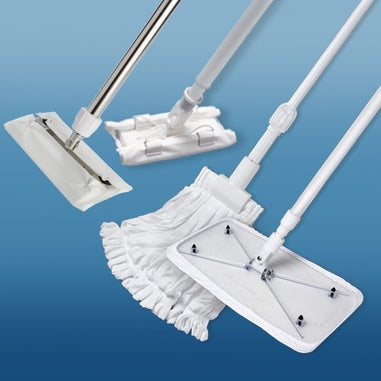- No products in the cart.
Gloves are a staple in every laboratory and are often the first and most essential part of PPE (personal protective equipment) that persons working in laboratory environments reach for.
The main purpose of wearing gloves in laboratory and workplace environments is to protect both the user and the product by minimizing particulate transfer. Choosing the right glove is essential for maximum protection of both the user and the product. When deciding on which type of glove will best suit your workplace’s needs; consider these five criteria:

Particle Count
This refers to the number of particle contaminants that come off the gloves. Powder latex gloves have high particle counts.
Extractable Count
These are the number of elements extracted from the gloves in an immersion test. Measured in Parts Per Billion (PPB) or Grams per Square Meter (g/m2).
Electrostatic Discharge (ESD) Properties
This is the gloves' capacity to either dissipate or conduct a static charge. Nitrile exhibits excellent ESD qualities.
Dexterity
The flexibility and fit of the glove. Latex has a tighter form fit, while nitrile gloves have a moldable memory that reduces fatigue.
Chemical Compatibility
How the glove material responds to chemical exposure. Latex can protect well against acids, while nitrile has a broader range of resistance and performs well with both acids and solvents.
Cleanroom Rating
A cleanroom is an enclosed manufacturing space that is designed to protect specialty consumer goods such as microelectronics, pharmaceuticals, food, or aerospace equipment from particulate contaminants. Complex or large-scale productions may require sizable, state-of-the art cleanrooms, while in other circumstances, modular designs may suffice. What all cleanrooms have in common is that the room itself is under positive pressure and the air is filtered.
Air Cleanliness Classes for Cleanrooms - ISO 14644-1
|
Classification |
FED STD 209E Equivalent |
Maximum Concentration Limits (particles/m3) |
|||||
|
≥0.1µm |
≥0.2µm |
≥0.3µm |
≥0.5µm |
≥1µm |
≥5µm |
||
|
ISO 1 |
NA |
10 |
2 |
0 |
0 |
0 |
0 |
|
ISO 2 |
NA |
100 |
24 |
10 |
4 |
0 |
0 |
|
ISO 3 |
Class 1 |
1,000 |
237 |
102 |
35 |
8 |
0 |
|
ISO 4 |
Class 10 |
10,000 |
2,370 |
1,020 |
352 |
83 |
0 |
|
ISO 5 |
Class 100 |
100,000 |
23,700 |
10,200 |
3,520 |
832 |
29 |
|
ISO 6 |
Class 1,000 |
1,000,000 |
237,000 |
102,000 |
35,200 |
8,320 |
293 |
|
ISO 7 |
Class 10,000 |
N/A |
N/A |
N/A |
352,000 |
83,200 |
2,930 |
|
ISO 8 |
Class 100,000 |
N/A |
N/A |
N/A |
3,520,000 |
832,000 |
29,300 |
|
ISO 9 |
Standard Room |
N/A |
N/A |
N/A |
35,200,000 |
8,320,000 |
293,000 |
Finding the Right Fit
Lab Pro offers both nitrile cleanroom and latex gloves to suit a variety of needs, purposes, and preferences. To start, it is important to select the right glove size. Lab Pro offers a variety of glove sizes (XS, S, M, L, XL, XXL) in both nitrile and latex gloves. A proper fit ensures the highest protection. Gloves also come in different cuff lengths, with longer cuffs adding more protection. Lab Pro’s glove selection guide offers an in-depth review on size and fit, as well as exact measurements.
While nitrile and latex gloves both offer a diverse size range, differing cuff lengths, and ambidextrous fit; there are key differences between the two varieties that are essential to consider when choosing the right gloves for your laboratory or workplace.
Differences Between Nitrile Cleanroom Glove and Latex Cleanroom Gloves
Nitrile Cleanroom Gloves
Nitrile, also known as nitrile butadiene rubber, is a synthetic rubber that is derived from butadiene and acrylonitrile. Nitrile gloves are powder-free, come in 100% nitrile material, and are the most popular material for gloves in laboratory and cleanroom environments. Nitrile became popular in the last 30 years as a latex alternative. While not initially as elastic as their latex counterparts, they have a “break-in” period where the material properties adapt to the hand for a more custom fit. Nitrile gloves are three times more puncture resistant than their latex counterpart. The extra durability comes in at an advantage making them more resistant to certain kinds of chemicals, as well as physically durable.
Nitrile gloves are perfect for use in labs that frequently handle harsh or corrosive chemicals like MEK, Acetic Acid, Ethylene Glycol, and Sodium Hydroxide. They are also useful in biotechnical and electrical manufacturing laboratories as they have static-dissipating properties that make them effectively anti-static. Nitrile gloves are also suited for medical environments, as they eliminate the chance of adverse latex allergy reactions.
Lab Pro’s nitrile gloves are ambidextrous and come with textured fingers for both wet and dry handling. Along with different sizes for different users, they also come in different lengths with rolled cuffs for easy application.
Pros:
- Eliminate latex allergies.
- Resistant to a wide range of chemicals
- Chemically durable - protects from alkalis, acids, alcohols, and ketones.
- Physically durable - thicker than latex.
- Ergonomically functional - comfortable use, beaded cuffs, and textured grips.
- Lowest amount of particulates.
- Excellent ESD qualities.
Latex Cleanroom Gloves
Latex gloves are the common standard in disposable gloves. They were recommended as essential protection against bloodborne pathogens, and have since become the most ubiquitous symbol of medical and laboratory PPE. Latex is a natural material made from organic tree sap and offers a good medium of both comfort and protection as it has an excellent barrier. Their diversity in application and use, comfort, and cost-effectiveness make them the ideal choice for general wear.
Lab Pro offers standard, powder-free, and textured latex gloves to fit every user's needs.
Latex gloves are ideal when sensitivity and high dexterity are required of the user. Latex protects against alcohol, acids, and ketones. For a comprehensive overview of glove and chemical compatibility, consult Lab Pro’s Glove Chemical Compatibility Chart in their glove selection guide.
Powder-free gloves are chlorinated, meaning they undergo a process where they are treated with chlorine, rinsed with water, and then dried. This removes the majority of the powder residue and latex proteins. The advantage to powder-free latex gloves is that they are usable to wearers with more sensitive skin, are slightly stronger, and they can be applied to more versatile environments. Latex gloves also come in textured versions for optimum grip.
Pros:
- Flexible and comfortable.
- Protect against alcohols, acids, and ketones.
- Come in standard, powder-free, and textured varieties.
- Ideal when optimal dexterity is required
For over 40 years, Lab Pro Inc. has been committed to delivering the highest quality cleanroom gloves, distance learning kits, lab supplies, chemicals, and cleanroom PPE apparel to teaching institutions and laboratories worldwide. To learn more, visit the biggest Lab Supply showroom in California, or contact us online or at 888-452-2776.












































